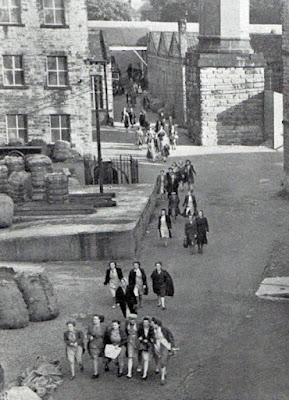 |
| Photograph of Edward Clay, from Edward Clay & Sons, Ossett |
Shoddy is the production of a recovered or recycled inferior quality yarn or fabric. It is made using the shredded fibres of woollen knitted cloth (cardigans, sweaters) rags or tailors’ clippings that gave a length of threaded material to be mixed with new wool and formed into reclaimed cloth. The negative association to the word ‘shoddy’ has arisen because shoddy was a low status fibre that poor people wore and was made into overcoats, military uniforms, blankets, and horse rugs. Rags that weren’t mixed with new wool became flock and ended up being used for upholstery or to stuff mattresses or saddles. Shoddy production created a wide range of associated trades from rag and bone men, to rag merchants, rag sorters and packers, dyers, rag traders and mill owners.
Mungo and Shoddy in Ossett
 |
| The unofficial coat of arms of Ossett (image courtesy of www.ossett.net) |
In the early 19th century, the Napoleonic Wars led to a shortage of wool imports and woollen products. Clever business owners repurposed wool out of waste wool. Shoddy was first made in Batley by Benjamin Law in 1813. Between 1800 and 1850 the mungo and shoddy trade led to a tripling of the populations of the towns of Batley and Dewsbury. This expansion led mungo and shoddy producers to look to neighbouring towns for new mill sites.
Why Ossett?
Ossett’s location on the river Calder and its new
railway station led to it becoming home to over forty mills, numerous dye sheds
and rag warehouses in the 1850s.
The Calder and Hebble Navigation was finished in 1770 providing waterways to transport mungo and shoddy. The river Calder was also used by Ossett’s mills in the recovered wool production process.
In 1848, railway stations opened across Batley, Dewsbury, Morley and Ossett. Huge bales of rags could be brought in from all over the UK and Europe. Finished mungo and shoddy was easily exported by rail from these towns.
Rag merchants at the time organised huge rag auctions at train station forecourts that were incredibly popular.
 |
| Victoria Mill, 1950s, female staff leaving for
home after work. (Image courtesy of Neville Ashby, www.ossett.net) |
From Rags to Riches
The mungo
and shoddy industry brought huge wealth to the mill owners in Ossett. These
industrialists were able to buy land and build detached Victorian villas in
Ossett with their newfound wealth.
John Clay spoke of the number of these families that bought second homes in Runswick Bay on the North Yorkshire Coast and how it became referred to as ‘Ossett by the Sea’.
The descendants of several mungo and shoddy mill owning families in Ossett remain in the town today.
 |
| Poster for the sale of Flushdyke Mill, Ossett (image courtesy of Kirklees Museums & Galleries) |
19th Century Recycling to 20th
Century Industrial Decline
How did this great idea to recycle wool from
leftover rags not become a green recycling industry today?
Repurposing wool was a great example of recycling. Leftovers of textile waste and dust from the mungo and shoddy process were even spread over soil in the nearby rhubarb growing fields as fertiliser! Whilst the idea of recycling woollen rags and reusing them was a great idea, the working conditions in the 1800s in the mills and rag warehouses were poor.
Breathing in textile dust all day caused ‘shoddy fever’. Women often worked as rag sorters and children fixing broken looms. There were several deaths due to accidents with poorly maintained machinery.
After the Second World War the mungo and shoddy industry fell into decline. With the arrival of synthetic fibres and ‘off the peg’ suits, wool was less in demand. Surviving mills have diversified into producing other felt products using mungo and shoddy rather than products for the garment industry. Products for mattress fillings, hanging basket liners and insulation are still produced using a similar process. Today with the climate crisis, businesses are looking again at the processes of mungo and shoddy to see how they can be transformed into a safe modern business that is great for the environment.
Share Your Stories
People in Ossett are rightly very proud of their mungo and shoddy producing heritage. We're creating an exciting new Wakefield Library & Museum in the heart of Wakefield City Centre, and we need your stories.
We would love for the people of Ossett and the surrounding area to add their memories, stories, photographs and objects from the mungo and shoddy industry as part of the new museum. If you are interested in taking part, please email museums@wakefield.gov.uk
For more information about another important industry in the Wakefield district, clog manufacturing, click here|
|


No comments:
Post a Comment
We would love your comments - though they may take a day or two to appear.